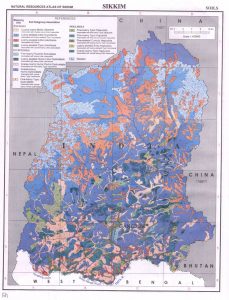Soils of Sikkim
- Sikkim is a small, extremely mountainous state in the Indian Himalayas with sharply defined and extremely steep watersheds.
- Although, Sikkim is only about forty miles in width and seventy miles in length, its altitude escalates rapidly from about 300 m above mean sea level in the South to about 8583 m along the Himalayan Kanchenjunga range.
- Agriculture is mostly concentrated in the lower mountain ranges, primarily in the East and South Districts.

- Nomadic high-altitude Legend 6 livestock herding (primarily goats, sheep and yaks) is found along the borders of Nepal, Bhutan and in the North District approaching the Tibetan Plateau.
Different Series Soil in Scheme (Deep Analysis)
Markong Series (M):
- It comprises moderately deep, well-drained loamy skeletal soil with dark brown to dark reddish brown colour.
- They have been developed on mica schists.
- This soil occurs on strongly sloping (10-15%) hill top with moderate to severe erosion. Soils are under moderately dense forest and pasture land.
- The Markong Series is tentatively classified as a member of loamy skeletal mixed thermic family of Topic Haplumbrepts.
Putuli Series (p):
- It comprises shallow excessively drained dark brown loamy skeletal soil having some rock particles scattered over the surface.
- These are developed on micaceous gneissic parent rock of talus deposits.
- These Soils of Sikkim occur on moderately sloping and very steep upper hill slopes.
- They are moderately to severely eroded and are susceptible to landslides.
Lingtse Series (L):
- It comprises very deep, moderately well-drained fine loamy Soils of Sikkim with dark grayish brown to dark brown colour.
- They have been developed on gneissic parent rock. These soils occur on steep low hill slopes and moderately eroded.
- The Soils of Sikkim are under terraced cultivation.
- The Lingtse Series is tentatively classified as a member of fine loamy mixed thermic family of Typic Dystrochrepts.
Thekabong Series (T):
- It comprises moderately deep, moderately well drained loamy skeletal Soils of Sikkim with dark grayish brown in colour.
- They have developed on micaceous gneissic parent rock.
- These Soils of Sikkim occur in the steep to very steep middle and lower slopes of hill.
- Soils of Sikkim are bench terraced for cultivation.
- The Soils of Sikkim are moderately eroded and susceptible to severe erosion.
Machong Series (MA):
- It comprises moderately deep moderately well-drained, grayish brown fine loamy soils.
- They have been formed from the underlain micaschists.
- These Soils of Sikkim occur on the moderately steep to steep low hill slopes and piedmont.
- The Soils of Sikkim are under terraced cultivation.
- Erosion is moderate to severe.
Chatrikhola Series (C):
- It comprises deep, moderately well-drained fine loamy soils with very dark grayish brown to dark brown colour.
- They are developed on micaceous gneiss parent rock.
- These Soils of Sikkim occur on steep to very mid slope of low hill slopes and rare moderately to severely eroded.
Gompa Series (G):
- It comprises shallow excessively drained loamy skeletal soils within brown to dark brown colour.
- They have been developed on gneissic parent rock.
- This soil occurs on moderately sloping and steep to very steep escarpments.
- The Soils of Sikkim are under severe to very severe erosion and are susceptible to sliding.
Losep Series (LO):
- It comprises deep, moderately well-drained, loamy skeletal soils with grayish brown to yellowish brown colour.
- They have been developed on colluvial material over gneissic parent rock.
- These Soils of Sikkim occur on steep lower slopes of hills and are moderately to severely eroded.
Namthang Series:
- It comprises deep, well-drained, loamy skeletal soils with brown to dark yellowish brown colour developed from phyllite parent rock occurring on moderately sloping to strongly sloping mid hill slopes and are moderately eroded.
- Soils of Sikkim are under paddy cultivation.
Simikara Series:
- It comprises moderately deep excessively drained coarse loamy, fragmental Soils of Sikkim with yellowish brown to light olive brown colour and developed on micaschist parent rock.
- This soil occurs on very steep escarpment slope and is severely eroded. Soils are under dense forest.
Nandugaon Series:
- It comprises well-drained coarse loamy, fragmental soils with brown to dark brown colour, developed from sandstone parent rock.
- The soil occurs on steeply sloping mid and upper part of hills are severely eroded.
- Soils of Sikkim are under predominantly cultivation maize.
Hilly Series:
- It comprises very deep moderately well-drained fine loamy soils with dark reddish brown to reddish brown colour developed on gneissic parent material.
- The soil occurs on steeply sloping upper hill slope and is moderately eroded.
- Soils of Sikkim are under cultivation.
Padamchen Series:
- It comprises moderately deep, moderately well-drained, fine loamy soils with brown to yellowish brown colour and developed from gneissic parent material.
- This soil occurs on moderately steep to upper hill slope with severe erosion under thin forest vegetation.
Taraku Series:
- It comprises very deep, moderately well-drained fine loamy soils with brown to dark colour developed on sand stones.
- Soils of Sikkim occur on moderately steep to steep upper and midhill slopes and are moderately eroded.
- Soils of Sikkim are under horticultural crops.
Majitar Series:
- It comprises deep, well-drained loamy soils with grayish brown to light gray colour.
- They are of alluvial and collurial origin.
- This soil occurs on gently sloping to moderately sloping uplifted river terraces and is susceptible for river bank erosion and flooding.
- Soils of Sikkim are under horticultural crops